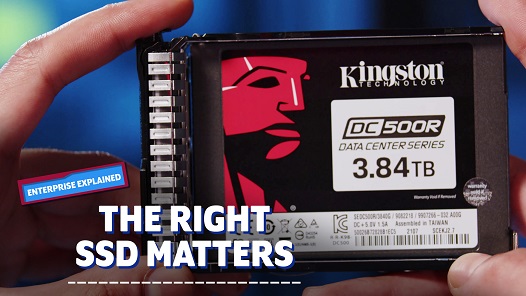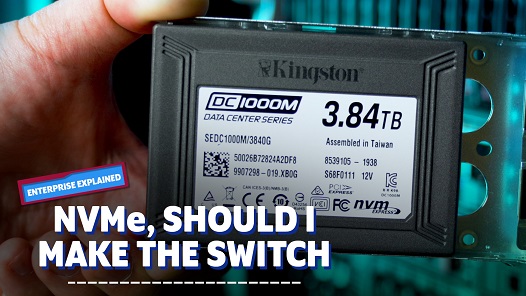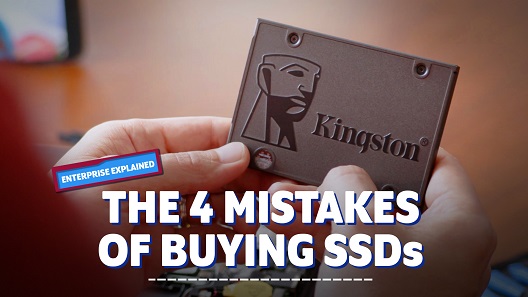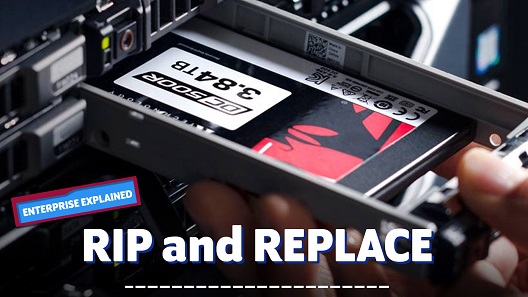Ask a Server SSD Expert
Planning the right solution requires an understanding of your project’s security goals. Let Kingston’s experts guide you.

For some IT professionals, there's confusion over solid-state drives (SSDs). Some have the impression that they’re all created equal with no real difference between them because they're only flash memory. That is not the case.
The way an SSD is built for client machines like a notebook or desktop (a daily work device) versus how an SSD is built for a data center application is vastly different. The workloads are very different. A server workload usually maintains 100-percent duty cycle 24 hours a day, seven days a week, year-round. But when we work on our computers throughout the day, even on a virtual machine, we’re only using minimal resources with a lot of idle time.
The drives that are put in a server need to withstand the constant demand and performance requisites for heavy-duty use. One cannot simply take an SSD out of a laptop and expect it to operate in a data center, that’s like expecting a standard car engine to power a semi-truck. Data centers need drives that are enterprise-grade and purpose-built to deliver predictable performance at scale.
SSDs are being used in more applications in the data center than ever before. In the early days, SSDs were somewhat unknown. IT was a bit afraid of them, but as they have gained more confidence in the technology, SSDs are shifting into more high-performance applications, and that's where this type of performance consistency becomes important.
To create SSDs that are tuned to the demands of a data center the focus is on delivering performance consistency as it relates to IOPs delivery and latency. To test this, performance scripts are created that look at every IO over a very long test pattern.
What manufacturers tune for and what IT architects want to see are straight lines of consistency when benchmarked with their workloads. There is never 100-percent perfect consistency, but what is avoided is a sawtooth pattern or what’s referred to as a “Christmas Tree” pattern in IO delivery when the performance data results are graphed.

A drive that is not properly tuned may experience big swings in performance. At one point, the drive may perform 50,000 IOPs, and then it drops to 20,000 IOPs before bouncing back up 60,000 IOPs. While the high numbers look excellent for a specification sheet and sales literature, performance spikes don’t tell the whole performance story. Instead, Kingston enterprise-class data center SSDs are designed to deliver consistent levels of performance even if it may mean sacrificing some peak levels of performance.

This consistency ensures that customers aren’t disappointed by the lack of performance, but rather have a predictable advantage for managing their storage clusters. A lot of what makes this straight line and the consistency happen goes into the SSD firmware design, the size of the over-provision area and the write cache size.
With better predictability our customers gain the ability to build applications around the consistent performance, while also meeting service-level agreements.
With so many background operations, e.g., the TRIM command, garbage collection and host commands all need to be taken into consideration from a firmware tuning perspective. On the hardware side, we use large DRAM caches on the SSDs to hold all or a large portion of the drives mapping table and is used as a write buffer for incoming writes to the SSD.
Latency acts in the same way as IO. For example, if the latency is cruising along at sub-5ms and then jumps up to 500ms before coming back down to 5ms, there is a problem as this performance inconsistency could show up in the application somewhere.
Data center customers have become much more sophisticated over the years, where in the past an SSD supplier could provide them a good client-level drive and they'd run with it, and then simply rip out and replace it with another cheap client drive when something went wrong. But today, datacenter customers are peeling back the onion on SSDs as they know these inconsistencies exist so they're testing for them.
The best enterprise SSDs today utilize large DRAM caches and are tuned within the firmware to deliver on consistency. In fact, about 90 percent of what smooths out these lines is done in code in firmware – which is a big differentiator for Kingston products.
In the market today, roughly 80 percent of the SSDs that go into service are still Serial ATA (SATA). The SATA standard maintains relatively fast transfer rates and uses a relatively small footprint on the motherboard, which means more drives with excellent RAID profiles.

There is a big movement within the storage industry to move away from the SATA interface and use NVMe (non-volatile memory express) as NVMe was designed from the ground up for Flash based SSDs. In fact, many of the recent analyst projections suggest that within the next couple of years there will be a major shift in mainstream servers as NVMe promises to break the IO and latency limitations associated with legacy hard drive interfaces.
SSDs for the last ten years have been built using hard drive interfaces and it made sense initially however storage experts have known for many years that there was a better interface for SSDs. PCIe is a great interface for SSDs but many servers are limited today in their capacity and sheer number of available lanes.
The simple fact is that people can’t turn that switch overnight to migrate to NVMe.
Kingston’s criteria for performance consistency delivery is the same, whether building for a SATA or NVMe interface. NVMe inherently provides lower latency and higher IO delivery, so customers expect more performance obviously out of an NVMe drive.
When choosing the right enterprise SSD, data centers should look for SSDs that will reduce latency and limit any possibility of IO cliffs.
Lastly, the customer has to consider if their infrastructure is ready to utilize the newer faster storage interfaces. SSDs matter, and the selection customers make for their data centers is becoming increasingly critical.
#KingstonIsWithYou

Planning the right solution requires an understanding of your project’s security goals. Let Kingston’s experts guide you.

Choosing the right SSD is important since not all SSDs are alike. When it comes to data centers, choosing an SSD with the right performance consistency with low latencies that’s specifically built for enterprise and data center workloads is key for consistent and reliable performance.

With the rise of data, need of edge computing and edge networks data center upgrades with NVMe SSDs enable more possibilities than before.

SSDs are all alike, right? You plug it in and instantly have all of that Flash Memory available for your workload? Right? If you answered yes, then you’ve probably fallen to one of the 4 biggest mistakes you could make when selecting your SSD.

Some enterprises still make use of client SSDs to handle high-intensity server tasks, then rip & replace them when they fail to maintain the required standard of performance. Learn why that’s a false economy and how enterprise-level drives can increase organizational efficiency.